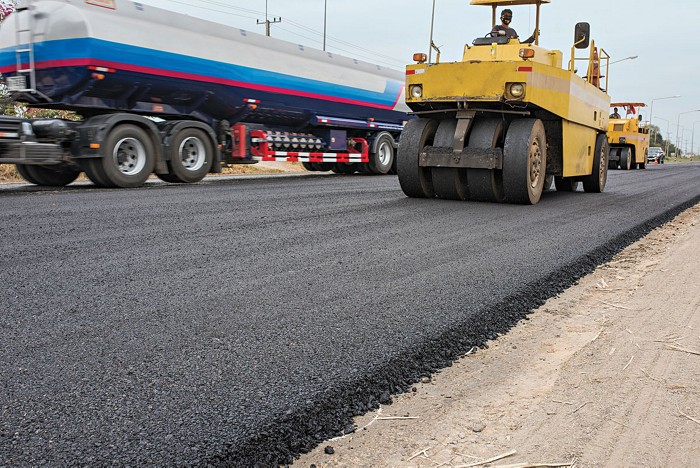What Does A1 Professional Asphalt & Sealing Llc Mean?
What Does A1 Professional Asphalt & Sealing Llc Mean?
Blog Article
The smart Trick of A1 Professional Asphalt & Sealing Llc That Nobody is Discussing
Table of ContentsThe 4-Minute Rule for A1 Professional Asphalt & Sealing LlcA1 Professional Asphalt & Sealing Llc for BeginnersWhat Does A1 Professional Asphalt & Sealing Llc Do?The Main Principles Of A1 Professional Asphalt & Sealing Llc The Basic Principles Of A1 Professional Asphalt & Sealing Llc

The oil in a car engine is not simply oil. The REOB consists of all the additives that were in the waste oil as well as the wear metals from the engine (mostly iron and copper).
Nevertheless, by making numerous blends making use of different REOB examples and different asphalt binders, the variations greatly can be averaged out. Several States offered examples of well-known REOB composition to TFHRC scientists, that assessed the examples to contrast the percent of added (understood) REOB to the found (checked) amount. The analyses showed an equivalent portion of added and found REOB.
Getting My A1 Professional Asphalt & Sealing Llc To Work
None of those States understood that the asphalt they were buying consisted of REOB. One State urged its samples had no REOB - https://www.edocr.com/v/1vn6dav1/a1asphaltsealng/a1-professional-asphalt-sealing-llc.
Of the 1,532 examples examined, 12 percent contained REOB, and some included substantially high levels of it at 1020 percent. The highest degree was 34 percent in an example from Texas, which TxDOT had actually utilized in a patching compound. This testing also revealed the presence of phosphoric acid in 11 percent of the samples, and 2 percent consisted of ground tire rubber.
2 years earlier at TRB's annual conference, the Federal scientists held an REOB workshop and offered the findings of their laboratory evaluations to a standing room-only crowd. Some firms do not specifically ban REOB, they do enforce physical examinations that avert its useeffectively a restriction. Others do not ban it by specification, however have contracts with asphalt distributors to stay clear of making use of REOB
A Biased View of A1 Professional Asphalt & Sealing Llc
Ohio and Texas restriction degrees to much less than 5 percent of the asphalt. To establish a reputable test approach that all States can make use of, the TFHRC scientists set up a round-robin test strategy.
In overall, the scientists prepared and shipped 720 blends. The participants are checking the examples individually utilizing the guidelines offered by the TFHRC scientists. The round-robin testing is nearly finished, and TFHRC is in the procedure of accumulating the results. The output will be a proposed AASHTO test approach that any type of State can take on and utilize (asphalt paving repairs).
The sidewalk with REOB, which lies 0.6 mile (1 kilometer) from the pavement without REOB, has similar subgrade, traffic thickness, and climate. However, the sector of Highway655 with 5 to 10 percent REOB showed substantial fracturing. In this instance, the presence of REOB was the determined reason for cracking at a reduced temperatures.
"In our experience in copyright, also tiny quantities of 23 percent can be a trouble." A section of test sidewalk in Minnesota (MN1-4) found to have REOB likewise broke too soon. The sidewalk carried out well for the initial 3 to 4 years, however after that began to crack. This pavement is likewise subject to reduced temperatures.
The Ultimate Guide To A1 Professional Asphalt & Sealing Llc
The examinations were not considerable, yet they revealed that at degrees of 6 percent or more, the tensile stamina of the asphalt dropped dramatically. At a level of 3.5 percent REOB, the variant in the physical examination techniques was above the effect of REOB. It was difficult for researchers to examine whether REOB was existing. https://worldcosplay.net/member/1754688.

One binder parameter thought about is the difference between the reduced temperature level essential requirements temperature level for tightness (S) in the flexing light beam rheometer and the flexing light beam rheometer creep incline (m-value) noted as Tcritical. TC = TC (S) TC (m-value). Assessment of this specification is still recurring. 2 independent study teams, one from AASHTO and the other from the Asphalt Institute, wrapped up that more research study is required on the usage of REOB in asphalt.
Previously, all asphalt screening determined engineering properties such as tightness. These examinations do disappoint what materials click resources had actually been contributed to the asphalt. One example gotten throughout the TFHRC research study had an extremely unusual analysis. The sample had the adhering to examination results: Superpave PG 64-28 with a heat quality of 67.3 Tcritical on the flexing beam rheometer was 6.7 levels Celsius.

The Ultimate Guide To A1 Professional Asphalt & Sealing Llc
These results demonstrate there are weaknesses in the standard design screening procedures that might be made use of. The producer might have a financial advantage and the item passes all the standardized examinations, yet the item may not be advantageous to making certain lasting efficiency. To resolve this issue and the growth of brand-new asphalt ingredients and extenders, TFHRC is beginning a research program to utilize portable spectroscopic devices, x-ray fluorescence spectroscopy, and Fourier change infrared spectroscopy to make it possible for evaluations to be performed in the area as opposed to needing to take examples back to the lab.
Report this page